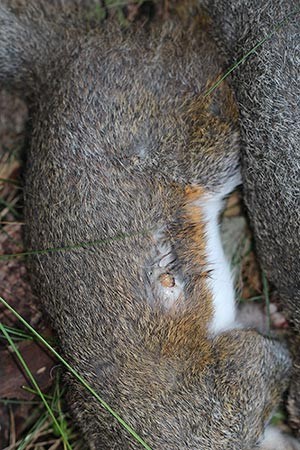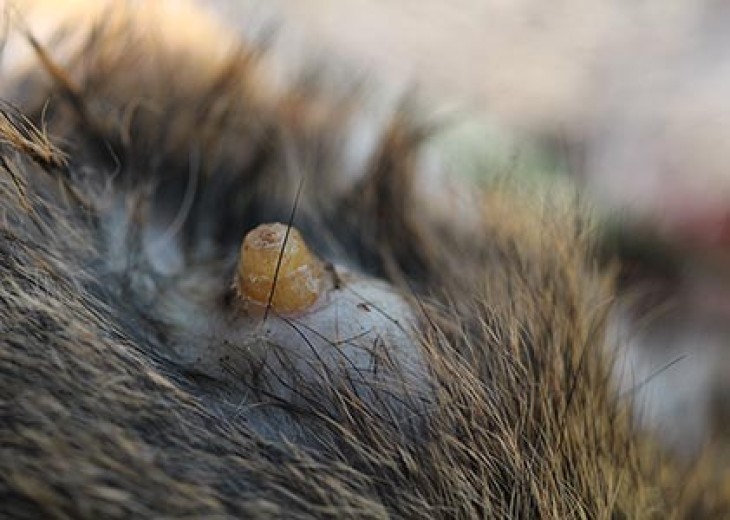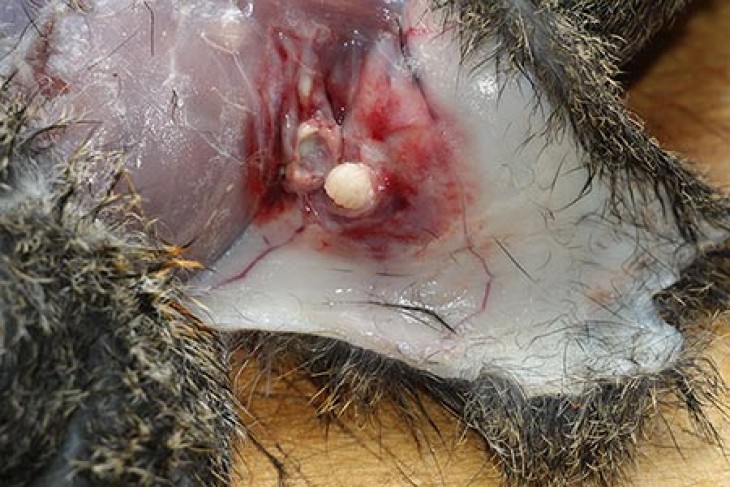Like a lot of kids who grew up rural, I was introduced to many of the wonders of nature through hunting. Specifically squirrel hunting, which is how most kids get their start. I don’t do much anymore, but I try to get out a few times each autumn on those first cool days. With luck, I can put up enough squirrels for a deer camp stew in November, over which all the members in camp can reminisce about being young.
My trip afield this year was a little earlier than normal, which put me smack in the middle of botfly larvae season – a thoroughly disgusting time of year. There are some 60 botfly species in the U.S. and each have a preferred host. The tree squirrel botfly is called Cuterebra emasculator, I guess because years ago it was believed that the larvae consumed testes. The University of Florida has a pretty reputable looking and thorough introduction that you can read here.
According to that webpage, the parasite has a year-long, four-stage lifecycle. The adults, which are relatively large flies that look sort of like small bumble bees, emerge in late spring or early summer and mate. Females lay their tiny eggs on twigs or leaves, and larvae develop within the eggs. When a squirrel comes by, the larvae detect the animal’s body heat or CO2 from within the egg, then emerge and try to latch on. If they’re successful, they’ll look for an orifice or wound through which to enter the host’s body, at which point they’ll take up residence beneath the hide. They consume lymph fluid (not blood) and grow, molting twice. The squirrel’s body creates the boil that houses the larva, and the larva makes a hole in the boil through which it breathes and excretes waste. After about three or four weeks it backs out of the hole, drops to the ground, crawls into the soil, and pupates. Come spring, an adult fly emerges and the whole cycle starts again.
Fascinating and wicked gross, I know.
Botflies are native to the region. And like most obligate parasites, they need a healthy, living host to complete their life cycle. It’s not in their best interest to harm their host, and so, in a few weeks, the larva will drop off and the squirrel will resume a healthy, maggot-free life.
If you’re a squirrel hunter who’s a little rattled by all this, keep in mind that the parasite you’re looking at can’t infect you. It only cares about growing and then dropping off and pupating – it’s not looking for another host. Technically, if you were crawling around naked in the branches of a tree in June you could conceivably contract an infectious, just-hatched larva in the first instar, but this is highly unlikely.
Know, too, that the botfly grubs don’t affect the squirrel meat. Most larva I’ve ever seen were located on the rib cage; the shoulders and hams were perfectly fine to eat. Just cut around the worm and discard that part. If you’re exceptionally adventurous you might try eating the larva, something traditional Inuit hunters reportedly do with the botfly grubs they find in caribou. That factoid came from Wikipedia, so may or may not be true. I can vouch firsthand, though, that yellow jackets seem to have a fondness for them. The first squirrel I harvested the other day had been dead for less than two minutes when a yellow jacket made a beeline for the grub. It was clear that it was after the worm, not the squirrel protein, as it paid no attention to the bullet entrance hole. The yellow jacket spent five minutes trying to pull the grub out of the carcass but couldn’t quite do it, so I worked it out with a knife, cut it into bee-sized slivers, and left it as a peace offering.





Discussion *